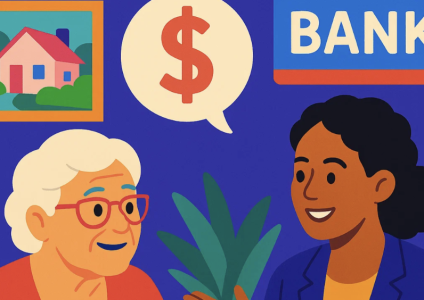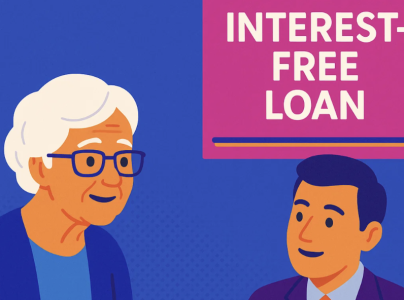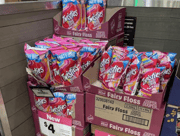Cost-of-Living Lifeline: Interest-Free Loans Offer Hope for Struggling Aussie Seniors
- Replies 6
If your fridge died tomorrow, could you afford to replace it? For many older Australians on the Age Pension, an unexpected expense like a broken appliance or a dental bill can spell financial disaster. But there’s a little-known lifeline available – one that sounds almost too good to be true.
Believe it or not, Age Pensioners and other low-income Aussies can get an interest-free loan to cover essential costs when money is tight. And no, this isn’t a dodgy scam or a “buy now, pay later” trap – it’s a government-supported program that’s helping thousands stay afloat.
In some special cases, the loan amounts can be higher (up to $3,000 for things like rental bonds or rates, and even $5,000 for vehicles or mobility scooters). The crucial point is that you only pay back exactly what you borrow, with no interest, no fees, and no hidden charges.
How can that be possible? Essentially, the loans are funded through a partnership between community organizations, government, and banks. The charity Good Shepherd Australia New Zealand administers NILS nationally (they actually started the program over 40 years ago), and National Australia Bank (NAB) provides the loan capital.
The federal government chips in by funding the running costs and recently committed an extra $48.7 million to keep the program going for another five years. Minister for Social Services Amanda Rishworth said she’s proud to back no-interest loans as a safe alternative to high-interest payday loans and buy-now-pay-later services that can send vulnerable people into debt spirals. With this support, Good Shepherd and NAB are able to offer thousands of these loans each year as “essential purchases” support for those doing it tough.
Importantly, NILS is not a cash handout – you don’t get money in your pocket to spend freely. Instead, the program pays the supplier directly for whatever item or bill you need to cover. This way, borrowers can only use it for legitimate essentials (no funding a weekend at the casino or splurging at the mall).
The loans are typically repaid over 12 to 24 months, with affordable installments tailored to your budget. In fact, repayments can even be arranged via Centrelink deductions; one borrower noted her loan was automatically repaid at about $38 a fortnight from her benefits, making it “so convenient” to manage.
More than 350,000 no-interest loans have been given out since 2003, helping low-income Australians like Edi Spina (pictured) purchase essentials without falling into debt. Edi, 60, was able to replace a broken washing machine thanks to an interest-free loan, rather than resorting to high-interest credit. The program’s “no interest, no fees” model means borrowers like her only repay what they borrow, preserving their financial dignity while keeping their heads above water.
Consider the story of Edi Spina, a 60-year-old who found herself in a tight spot not long ago. Edi had been struggling to make ends meet on her pension, and had even fallen into some buy-now, pay-later debt just to cover groceries. Then her washing machine broke down – an essential appliance she couldn’t live without – and she had no savings to replace it. Instead of turning to a predatory payday lender or going without, she learned about NILS through a local community center.
Edi got a $900 no-interest loan to buy a new washing machine and paid it off in manageable installments over 18 months, a rate that fit within her limited budget. “Without the opportunity of being eligible for the loan, I don’t know what else I would have done,” she says gratefully.
In fact, Edi was so relieved by how it worked that after repaying her first loan, she’s gone back for subsequent loans when new needs arose – a set of prescription glasses, and even a new fridge “You almost can’t wait to pay it off because you know you’re going to need it again,” she jokes, highlighting just how crucial this lifeline has become in her life.
Edi’s case isn’t an isolated one. Across Australia, tens of thousands of people are using no-interest loans each year to handle emergencies or important purchases they otherwise couldn’t afford. More than 36,000 NILS loans were issued in the last financial year alone, and demand is rising as the cost-of-living squeeze continues. Good Shepherd (the charity running the scheme) reports a 16% increase in loans over a recent six-month period, as more households find themselves stretched thin. It’s not just the stereotypical low-income single mum using the program, either.
According to NILS volunteers, they are now seeing new groups of people coming forward for help: “We have been seeing two groups of people who never come to us before... recently we have men [applying] because they are desperate,” said Mai Nguyen, a community volunteer in Melbourne’s western suburbs, noting that traditionally 95% of loan applicants were female.
She also mentioned a surge in working people – those who have jobs but still can’t make ends meet – now applying for no-interest loans as a last resort. This trend was backed up by Good Shepherd’s research head, Dr. Jozica Kutin, who observed that “people even on those slightly higher incomes are also struggling and requiring safe and affordable credit” in the current climate. In other words, the profile of who needs a helping hand is broadening, and that definitely includes a lot of seniors and pensioners feeling the pinch.
You also need to have lived at your current address for at least 3 months and be able to show you can repay the loan in small installments. There are no credit checks required, so you won’t be knocked back just for having a poor credit history; the program is more interested in whether the loan repayments are affordable for you going forward.
For many seniors, NILS ends up being a perfect fit. Older people are often debt-averse – you’ve spent a lifetime avoiding loans when possible – so the idea of borrowing can be uncomfortable. But an interest-free loan for an essential need is a different kind of beast. You’re not going into hock to buy luxuries; you’re simply smoothing out a necessary expense over time, without paying extra for the privilege.
Financial counselors even encourage schemes like NILS because they prevent folks on low incomes from resorting to far more dangerous forms of credit. “Too often, people in financial stress turn to high-interest payday loans. No interest loans offer a safer alternative, helping Australians borrow money without having to pay any fees or interest,” notes NAB executive Jessica Forrest, whose bank has provided over $560 million in loan capital to the program over two decades. That means a pensioner who might otherwise be tempted by a 40% interest payday loan (or racking up credit card debt) can avoid those debt traps altogether by choosing NILS.
It’s also worth mentioning that pride or stigma can be a barrier – some older individuals may feel there’s a catch or that it’s embarrassing to seek help. But the experience of those who’ve used the program often defies that stigma. “Trust, dignity and respect are the absolute bedrock of the NILS program,” says Dare Kavanagh, the national manager for NILS at Good Shepherd.
The loans are offered confidentially and delivered through local community providers who treat borrowers with kindness, not judgment. In many ways, it’s a community banking ethos: neighbours helping neighbours, backed by larger institutions. Financial dignity is a key goal – as Good Shepherd’s CEO Stella Avramopoulos put it, this support is about “providing dignity, stability, and a pathway to a better future” for vulnerable Australians. For seniors who’ve felt invisible or undervalued, that kind of respectful assistance can be as valuable as the money itself.
For older folks, it can mean the difference between suffering in silence (with a broken appliance or untreated medical need) and maintaining a decent quality of life. Even families are getting on board – NAB noted that a quarter of NILS recipients are single parents, and many are women escaping domestic violence, using the loans to rebuild their lives safely.
Yet, as an editorial observation, one can’t help but see the flip side: why are so many seniors and others finding themselves in a position of needing these microloans in the first place? The rising cost of living – from groceries to electricity to rent – is hitting pensioners especially hard. The Age Pension, while indexed to inflation, often lags behind the true cost increases in essentials.
Many retirees have little in the way of savings, and modest superannuation, if any. In that context, the booming demand for no-interest loans is also a symptom of a larger issue: persistent financial insecurity among older Australians. It’s fantastic that NILS is there to catch those who fall, but it raises a larger question of whether the social safety net (pensions, concessions, affordable housing, etc.) is adequately protecting our seniors. After all, relying on a loan – even an interest-free one – to pay for a basic need is not something most people envision for their “golden years.”
That said, NILS is filling a critical gap that traditional banks won’t address. Banks typically don’t bother with tiny loans of a few hundred or a couple thousand dollars to low-income people – the loans aren’t profitable for them, and many pensioners wouldn’t meet standard lending criteria anyway. Before programs like this, pensioners in a bind might have had nowhere to turn except perhaps charities (for one-off charity vouchers) or exploitative lenders.
So on balance, thank goodness the scheme exists. It’s a creative blend of government, non-profit and corporate cooperation that is delivering real help on the ground. It’s also available in over 600 locations nationwide, including regional and remote areas, so it’s not just a city thing. Community groups from St Vincent de Paul to local neighborhood centers are involved in assessing and granting these loans. In a way, it’s bringing back an old-fashioned concept – the idea of a community loan pool or credit union – but turbocharged with national support and interest-free terms.
As more seniors hear about NILS, we might see even greater uptake. Awareness is still a hurdle – many older Australians simply don’t know this option exists. If you mention “interest-free loan” to some, they might assume it’s a scam.
But as The Senior and other outlets are working to spread the word, hopefully the message is getting out: when you’re doing it tough, you’re not alone and there is help available. No-interest loans won’t solve all the financial challenges faced by retirees, but they can certainly ease the pressure of an emergency expense or an important purchase that can’t wait.
At the end of the day, the existence of this scheme is both reassuring and thought-provoking. It reassures us that there’s a safety valve when money is tight. But it also reminds us that even in a country like Australia, many seniors are living so close to the edge that an interest-free loan might be the only thing standing between them and hardship. It’s a patch fixing a hole in the system – an example of Aussie ingenuity and compassion, but also a sign of the times we’re in.
Read more: Less mortgage, more moolah: How Amanda saved $1,000 on her home loan

So what do you think? Is the rise of interest-free loans for pensioners a brilliant solution to a cost-of-living crisis, or a warning bell that highlights a deeper problem with how we support our seniors? It might just be a bit of both – and it’s a question worth pondering as we look toward the future of ageing in Australia.
Believe it or not, Age Pensioners and other low-income Aussies can get an interest-free loan to cover essential costs when money is tight. And no, this isn’t a dodgy scam or a “buy now, pay later” trap – it’s a government-supported program that’s helping thousands stay afloat.
What Is This Interest-Free Loan Scheme?
The program is formally known as the No Interest Loans Scheme (NILS), and it does exactly what it says on the tin. Under NILS, eligible individuals can borrow up to $2,000 to pay for essential goods and services – think a new fridge, a replacement washing machine, car repairs, medical or dental expenses – without paying a cent of interest, ever.In some special cases, the loan amounts can be higher (up to $3,000 for things like rental bonds or rates, and even $5,000 for vehicles or mobility scooters). The crucial point is that you only pay back exactly what you borrow, with no interest, no fees, and no hidden charges.
How can that be possible? Essentially, the loans are funded through a partnership between community organizations, government, and banks. The charity Good Shepherd Australia New Zealand administers NILS nationally (they actually started the program over 40 years ago), and National Australia Bank (NAB) provides the loan capital.
The federal government chips in by funding the running costs and recently committed an extra $48.7 million to keep the program going for another five years. Minister for Social Services Amanda Rishworth said she’s proud to back no-interest loans as a safe alternative to high-interest payday loans and buy-now-pay-later services that can send vulnerable people into debt spirals. With this support, Good Shepherd and NAB are able to offer thousands of these loans each year as “essential purchases” support for those doing it tough.
Importantly, NILS is not a cash handout – you don’t get money in your pocket to spend freely. Instead, the program pays the supplier directly for whatever item or bill you need to cover. This way, borrowers can only use it for legitimate essentials (no funding a weekend at the casino or splurging at the mall).
The loans are typically repaid over 12 to 24 months, with affordable installments tailored to your budget. In fact, repayments can even be arranged via Centrelink deductions; one borrower noted her loan was automatically repaid at about $38 a fortnight from her benefits, making it “so convenient” to manage.
A Lifeline for Those “Doing It Tough”
For seniors on fixed incomes, programs like this can be life-changing. “Thankfully – should the fridge break down or the computer crash – the NILS scheme is there to help vulnerable Australians get through tricky situations,” Minister Rishworth noted. It’s not charity – you do pay the money back – but it’s dignified, safe credit that won’t make a hard situation even harder. And many folks who’ve used NILS rave about the difference it made.More than 350,000 no-interest loans have been given out since 2003, helping low-income Australians like Edi Spina (pictured) purchase essentials without falling into debt. Edi, 60, was able to replace a broken washing machine thanks to an interest-free loan, rather than resorting to high-interest credit. The program’s “no interest, no fees” model means borrowers like her only repay what they borrow, preserving their financial dignity while keeping their heads above water.
Consider the story of Edi Spina, a 60-year-old who found herself in a tight spot not long ago. Edi had been struggling to make ends meet on her pension, and had even fallen into some buy-now, pay-later debt just to cover groceries. Then her washing machine broke down – an essential appliance she couldn’t live without – and she had no savings to replace it. Instead of turning to a predatory payday lender or going without, she learned about NILS through a local community center.
Edi got a $900 no-interest loan to buy a new washing machine and paid it off in manageable installments over 18 months, a rate that fit within her limited budget. “Without the opportunity of being eligible for the loan, I don’t know what else I would have done,” she says gratefully.
In fact, Edi was so relieved by how it worked that after repaying her first loan, she’s gone back for subsequent loans when new needs arose – a set of prescription glasses, and even a new fridge “You almost can’t wait to pay it off because you know you’re going to need it again,” she jokes, highlighting just how crucial this lifeline has become in her life.
Edi’s case isn’t an isolated one. Across Australia, tens of thousands of people are using no-interest loans each year to handle emergencies or important purchases they otherwise couldn’t afford. More than 36,000 NILS loans were issued in the last financial year alone, and demand is rising as the cost-of-living squeeze continues. Good Shepherd (the charity running the scheme) reports a 16% increase in loans over a recent six-month period, as more households find themselves stretched thin. It’s not just the stereotypical low-income single mum using the program, either.
According to NILS volunteers, they are now seeing new groups of people coming forward for help: “We have been seeing two groups of people who never come to us before... recently we have men [applying] because they are desperate,” said Mai Nguyen, a community volunteer in Melbourne’s western suburbs, noting that traditionally 95% of loan applicants were female.
She also mentioned a surge in working people – those who have jobs but still can’t make ends meet – now applying for no-interest loans as a last resort. This trend was backed up by Good Shepherd’s research head, Dr. Jozica Kutin, who observed that “people even on those slightly higher incomes are also struggling and requiring safe and affordable credit” in the current climate. In other words, the profile of who needs a helping hand is broadening, and that definitely includes a lot of seniors and pensioners feeling the pinch.
How to Qualify – And Why Many Seniors Do
The good news for older Australians is that being on the Age Pension generally makes you eligible for a NILS loan. The scheme’s criteria are pretty straightforward: if you have a Pensioner Concession Card or Health Care Card, or your income is below about $70,000 a year (single) or $100,000 (couples), you meet the basic eligibility tests. (And let’s face it, the maximum annual Age Pension for a single is far below $70k – it’s roughly around $26k – so pensioners automatically pass the income test.)You also need to have lived at your current address for at least 3 months and be able to show you can repay the loan in small installments. There are no credit checks required, so you won’t be knocked back just for having a poor credit history; the program is more interested in whether the loan repayments are affordable for you going forward.
For many seniors, NILS ends up being a perfect fit. Older people are often debt-averse – you’ve spent a lifetime avoiding loans when possible – so the idea of borrowing can be uncomfortable. But an interest-free loan for an essential need is a different kind of beast. You’re not going into hock to buy luxuries; you’re simply smoothing out a necessary expense over time, without paying extra for the privilege.
Financial counselors even encourage schemes like NILS because they prevent folks on low incomes from resorting to far more dangerous forms of credit. “Too often, people in financial stress turn to high-interest payday loans. No interest loans offer a safer alternative, helping Australians borrow money without having to pay any fees or interest,” notes NAB executive Jessica Forrest, whose bank has provided over $560 million in loan capital to the program over two decades. That means a pensioner who might otherwise be tempted by a 40% interest payday loan (or racking up credit card debt) can avoid those debt traps altogether by choosing NILS.
It’s also worth mentioning that pride or stigma can be a barrier – some older individuals may feel there’s a catch or that it’s embarrassing to seek help. But the experience of those who’ve used the program often defies that stigma. “Trust, dignity and respect are the absolute bedrock of the NILS program,” says Dare Kavanagh, the national manager for NILS at Good Shepherd.
The loans are offered confidentially and delivered through local community providers who treat borrowers with kindness, not judgment. In many ways, it’s a community banking ethos: neighbours helping neighbours, backed by larger institutions. Financial dignity is a key goal – as Good Shepherd’s CEO Stella Avramopoulos put it, this support is about “providing dignity, stability, and a pathway to a better future” for vulnerable Australians. For seniors who’ve felt invisible or undervalued, that kind of respectful assistance can be as valuable as the money itself.
Bigger Picture: A Band-Aid or a Blessing?
There’s no doubt NILS has been a blessing for those who’ve tapped into it. Over 1 million Australians have benefited from no-interest loans to date, and the program’s expansion means an estimated 1.3 million additional households could be reached in coming years. We’ve heard stories of people calling it “life-changing” and crediting it with helping them through crises without sinking into long-term debt.For older folks, it can mean the difference between suffering in silence (with a broken appliance or untreated medical need) and maintaining a decent quality of life. Even families are getting on board – NAB noted that a quarter of NILS recipients are single parents, and many are women escaping domestic violence, using the loans to rebuild their lives safely.
Yet, as an editorial observation, one can’t help but see the flip side: why are so many seniors and others finding themselves in a position of needing these microloans in the first place? The rising cost of living – from groceries to electricity to rent – is hitting pensioners especially hard. The Age Pension, while indexed to inflation, often lags behind the true cost increases in essentials.
Many retirees have little in the way of savings, and modest superannuation, if any. In that context, the booming demand for no-interest loans is also a symptom of a larger issue: persistent financial insecurity among older Australians. It’s fantastic that NILS is there to catch those who fall, but it raises a larger question of whether the social safety net (pensions, concessions, affordable housing, etc.) is adequately protecting our seniors. After all, relying on a loan – even an interest-free one – to pay for a basic need is not something most people envision for their “golden years.”
That said, NILS is filling a critical gap that traditional banks won’t address. Banks typically don’t bother with tiny loans of a few hundred or a couple thousand dollars to low-income people – the loans aren’t profitable for them, and many pensioners wouldn’t meet standard lending criteria anyway. Before programs like this, pensioners in a bind might have had nowhere to turn except perhaps charities (for one-off charity vouchers) or exploitative lenders.
So on balance, thank goodness the scheme exists. It’s a creative blend of government, non-profit and corporate cooperation that is delivering real help on the ground. It’s also available in over 600 locations nationwide, including regional and remote areas, so it’s not just a city thing. Community groups from St Vincent de Paul to local neighborhood centers are involved in assessing and granting these loans. In a way, it’s bringing back an old-fashioned concept – the idea of a community loan pool or credit union – but turbocharged with national support and interest-free terms.
As more seniors hear about NILS, we might see even greater uptake. Awareness is still a hurdle – many older Australians simply don’t know this option exists. If you mention “interest-free loan” to some, they might assume it’s a scam.
But as The Senior and other outlets are working to spread the word, hopefully the message is getting out: when you’re doing it tough, you’re not alone and there is help available. No-interest loans won’t solve all the financial challenges faced by retirees, but they can certainly ease the pressure of an emergency expense or an important purchase that can’t wait.
At the end of the day, the existence of this scheme is both reassuring and thought-provoking. It reassures us that there’s a safety valve when money is tight. But it also reminds us that even in a country like Australia, many seniors are living so close to the edge that an interest-free loan might be the only thing standing between them and hardship. It’s a patch fixing a hole in the system – an example of Aussie ingenuity and compassion, but also a sign of the times we’re in.
Read more: Less mortgage, more moolah: How Amanda saved $1,000 on her home loan
Key Takeaways
- No-Interest Loan Program: A government-supported scheme (NILS) allows Age Pensioners and low-income Australians to borrow up to $2,000 (sometimes more) interest-free for essential expenses like appliances, medical bills, car repairs, and more. Borrowers only repay what they borrow, with no fees or charges.
- How It Works: The program is run by charity Good Shepherd in partnership with NAB (which provides the loan funds) and is backed by federal funding. Loans are paid directly to suppliers (no cash in hand) and repaid in affordable installments (often over 12-24 months). Having a Pension or Health Care Card or a low income is enough to qualify in most cases.
- Impact on Seniors: With the rising cost of living, more Australians – including seniors on the Age Pension – are turning to these interest-free loans as a lifeline. The scheme helped over 36,000 people last year alone. It’s been credited with “changing lives” by keeping vulnerable people out of high-interest debt and helping them afford critical needs in tough times.
- Bigger Picture: Advocates praise NILS for providing dignity and financial relief (25% of recipients are single parents, 18% are domestic violence survivors, etc.). However, the growing demand also highlights the financial precarity of many older Australians. The program is a much-needed safety net, but it raises the question of whether more fundamental measures are required to address senior poverty and cost-of-living pressures in the long run.
So what do you think? Is the rise of interest-free loans for pensioners a brilliant solution to a cost-of-living crisis, or a warning bell that highlights a deeper problem with how we support our seniors? It might just be a bit of both – and it’s a question worth pondering as we look toward the future of ageing in Australia.
Last edited:











